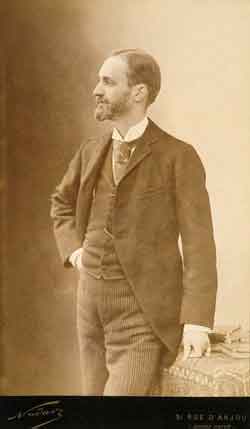George Eastman: A Strange Sort of Philanthropist
By Victoria Zimmer, intern, National Portrait Gallery

1890 / National Portrait Gallery, Smithsonian
Institution; gift of George Eastman House
A man of science, inventor, and industrialist who worked his way to the top, George Eastman could have been the protagonist in a Horatio Alger novel.
He established the Eastman Kodak Company in Rochester, New York, in 1892. The company produced affordable, easy-to-use film and cameras, thus revolutionizing photography in America. The success of his company made Eastman extremely wealthy, and he quickly became involved in philanthropic activities.
Eastman, however, was a strange sort of philanthropist. For example, he shied away from the limelight. In 1909 Eastman donated $1 million to the Massachusetts Institute of Technology. He requested that his gift remain anonymous, however, so MIT reported the donor as “Mr. Smith.”
In her biography on Eastman, Elizabeth Brayer writes that he derived great pleasure from the ensuing speculation in the newspapers and in society as to Mr. Smith’s true identity. Brayer further writes that when Eastman was eventually named as the anonymous benefactor, the New York Times ran an article about him entitled “Philanthropy under a Bushel,” after Eastman told the interviewer that he did not like to discuss his philanthropy.
Eastman, also unlike some of his contemporary philanthropists, did not employ an elaborate bureaucracy to handle and pare down pleas for assistance. That is not to say that Eastman was open to begging letters. In reality, he was unwilling to involve himself in personal requests for aid. Eastman wished to make contributions that would instead benefit the greatest possible number of people; he was particularly interested in improving the city of Rochester.
In a 1924 letter to Frank Seaman, his advertising agent in New York City, Eastman wrote, “I want to make Rochester for the thousands of people I have gathered here the best place on the face of the earth to live in and bring up their families.” Eastman contributed heavily to the University of Rochester, financing the creation of a music school, theater, dental dispensary, and medical school.
But Eastman was not content to simply write the check. He wanted a say in how the money would be used. Along this vein, he was determined to donate the bulk of his fortune while he was still alive. In 1925 he wrote to Dr. F. P. Keppel, president of the Carnegie Corporation, “it is my policy to place my money, all of it, before I die so that I can take some part in getting it into action.” In the same spirit, Eastman is said to have declared, “men who wait until they die before leaving their money are pie-faced mutts.”
Certainly a man of eccentricities and strong ideals, Eastman is a colorful figure in life and in death.
Cited:
George Eastman, Papers, University of Rochester, New York.
Elizabeth Brayer, George Eastman: A Biography (Rochester, NY: University of Rochester Press, 2006).
Elizabeth Brayer, “George Eastman,” Rochester History 102, no. 1 (1990).